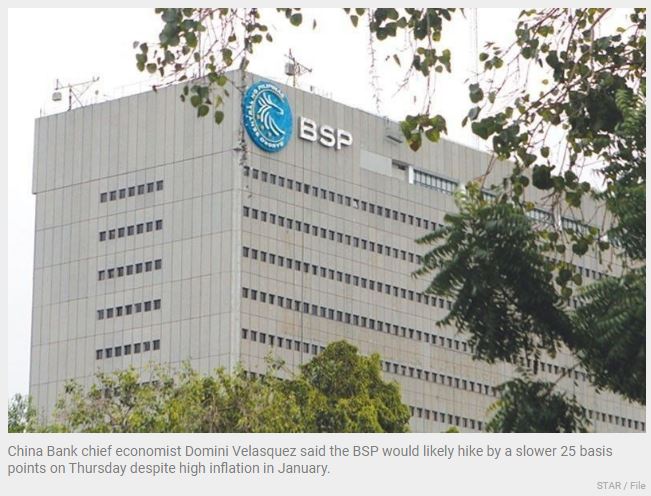Philippines: Economists split over level of BSP rate hike
MANILA, Philippines — Bank economists are divided on whether the Bangko Sentral ng Pilipinas (BSP) is going for a softer 25-basis-point interest rate hike or maintain the aggressive 50-basis-point increase this week, as inflation blew past expectations to hit a fresh 14-year high of 8.7 percent in January from 8.1 percent in December.
China Bank chief economist Domini Velasquez said the BSP would likely hike by a slower 25 basis points on Thursday despite high inflation in January.
“Our projections show that inflation is on a downward trend, albeit from a higher base given January’s 8.7 percent print. Supply side issues remain to be the major driver of inflation and non-monetary measures are urgently needed to bring food prices down,” Velasquez said.
She said the 350-basis-point rate increase that the BSP frontloaded in 2022 remains sufficient as a preemptive measure to clip demand-side inflation.
Velasquez explained that the BSP would take a more measured slowdown in tightening from February onwards given that the full impact of 2022 hikes have not yet been fully felt.
The stronger-than-expected gross domestic product (GDP) growth of 7.6 percent last year, slightly above the government’s 6.5 to 7.5 percent target, gave monetary authorities more elbow room to hike interest rates to tame inflation and stabilize the peso that slumped to an all-time low of 59 to $1 in October last year.
The benchmark interest rate hit a 14-year high of 5.50 percent last year from an all-time low of two percent, as the BSP matched the aggressive rate hikes delivered by the US Federal Reserve point-by-point to maintain a healthy 100-basis-point rate differential.
“Additionally, pent-up demand from last year will likely fade this year, slowing GDP growth to around six percent under an optimistic scenario. Hence, we are keeping our terminal rate of six percent, but open the case for a higher terminal rate in case demand-side inflation pressures materialize,” Velasquez said.
The economist sees inflation accelerating further to a fresh 14-year high of 8.9 percent in February, largely due to base effects, before trending slowly downward to the BSP target range of two to four percent in the fourth quarter.
Alvin Arogo, economist at Lucio Tan’s Philippine National Bank, also believes monetary authorities will raise interest rates by 25 basis points to 5.75 percent on Feb. 16.
Authorities, Arogo explained, are expected to consider the higher-than-expected 8.7 percent inflation in January, the lag in the effect of last year’s rate hike on aggregate demand as well as the decision of the US Fed to dial down its rate hike this month to 25 basis points.
“Our current baseline forecast is for inflation to reach 8.9 percent in February and gradually decline thereafter. We still think inflation will fall below the four percent target ceiling of the BSP in the fourth quarer, but the risk that this may not materialize has increased,” Arogo said.
UnionBank chief economist Ruben Carlo Asuncion said consumer demand remains upbeat and resilient, particularly among the middle and upper class households amid disinflation’s absence after the holidays.
“Whether this is still due to pent-up demand, dissavings and access to consumer credit, or some combination, producers and distributors are seemingly still confident to pass on the costs to consumers starved for onions and electricity (to run their gadgets and access online services), taking more frequent meals in the restaurants and malls with the re-opening, open to spend on leisure and travel, etc. as if incomes were unlimited,” Asuncion said.
Since there seems to be limited consumer pushback to ongoing pass-through dynamics, Asuncion said the BSP may be left with no choice but to settle for a more hawkish push for its terminal policy rate to be signaled starting this month.
“With high inflation all over the place and a CPI trajectory likely to end the year above the BSP’s target range, we now expect the BSP to hike by 50 basis points (previously a 25-basis-point hike was expected) for a policy rate of six percent. If the BSP opts for a 50-basis- point hike, the Monetary Board will disengage from the Fed and raise the risk of a terminal rate exceeding six percent, especially if faster disinflation in succeeding months is nowhere to be seen,” Asuncion said.
UnionBank’s updated CPI trajectory shows year-end inflation above the BSP’s inflation target range of two to four percent and it is likely that the BSP will not cut rates for the rest of 2023.
“This strong demand backdrop and ensuing inflation surge only calls for the BSP to either accelerate its terminal policy rate, which we believe is in the range of six percent or plan for a higher terminal rate before it ends its rate hiking cycle,” Asuncion said.
For his part, Security Bank chief economist Robert Dan Roces said that the inflationary environment continues to evolve away from expectations, prompting a significant shift regarding the central bank’s upcoming monetary policy decision.
“While the central bank was previously believed to be on track to increase interest rates by only 25 basis points in its next meeting, we now think a 50-basis-point hike may be in the cards, given the potential for hot inflation to drive higher inflationary expectations,” Roces said.
According to Roces, the persistence of rising core inflation adds further complexity to the inflationary outlook, suggesting that the underlying drivers of inflation may be moving away from a transitory nature, and rather the result of more persistent factors such as an unsolved food supply problem which drives up costs and bleeding into the core.
In this environment, Roces said the central bank must take a proactive stance in controlling inflation and anchoring inflation expectations to prevent the economy from spiraling out of control.
Source: https://www.philstar.com/business/2023/02/13/2244476/economists-split-over-level-bsp-rate-hike-


 Thailand
Thailand




